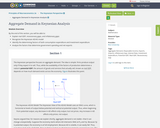
This 9 minute video will explain the role of banks in our economy. It will aid in the mastery of standard EPF. 6 and 12
- Subject:
- Economics
- Social Science
- Material Type:
- Lecture
- Provider:
- Marginal Revolution University
- Date Added:
- 10/31/2018

This 9 minute video will explain the role of banks in our economy. It will aid in the mastery of standard EPF. 6 and 12

This 8 minute video will explain the principles of Keynesian Economic Theory and the economist who came up with the idea, John Maynard Keynes. This video will enforce standard EPF. 5 (d)

Principles of Macroeconomics 2e covers the scope and sequence of most introductory economics courses. The text includes many current examples, which are handled in a politically equitable way. The outcome is a balanced approach to the theory and application of economics concepts. The second edition has been thoroughly revised to increase clarity, update data and current event impacts, and incorporate the feedback from many reviewers and adopters.Changes made in Principles of Macroeconomics 2e are described in the preface and the transition guide to help instructors transition to the second edition.


By the end of this section you will be able to:
Explain how exchange rate shifting influences aggregate demand and supply
Explain how shifting exchange rates also can influence loans and banks


By the end of this section, you will be able to:
Explain how expansionary fiscal policy can shift aggregate demand and influence the economy
Explain how contractionary fiscal policy can shift aggregate demand and influence the economy


By the end of this section, you will be able to:
Explain the nature and causes of unemployment
Analyze the natural rate of unemployment and the factors that affect it
Identify how undeveloped labor markets can result in the same hardships as unemployment


By the end of this section, you will be able to:
Contrast expansionary monetary policy and contractionary monetary policy
Explain how monetary policy impacts interest rates and aggregate demand
Evaluate Federal Reserve decisions over the last forty years
Explain the significance of quantitative easing (QE)

By the end of this section, you will be able to:
Analyze whether monetary policy decisions should be made more democratically
Calculate the velocity of money
Evaluate the central bank’s influence on inflation, unemployment, asset bubbles, and leverage cycles
Calculate the effects of monetary stimulus


In this chapter, you will learn about:
Macroeconomic Perspectives on Demand and Supply
Building a Model of Aggregate Demand and Aggregate Supply
Shifts in Aggregate Supply
Shifts in Aggregate Demand
How the AD/AS Model Incorporates Growth, Unemployment, and Inflation
Keynes’ Law and Say’s Law in the AD/AS Model


By the end of this section, you will be able to:
Explain real GDP, recessionary gaps, and inflationary gaps
Recognize the Keynesian AD/AS model
Identify the determining factors of both consumption expenditure and investment expenditure
Analyze the factors that determine government spending and net exports